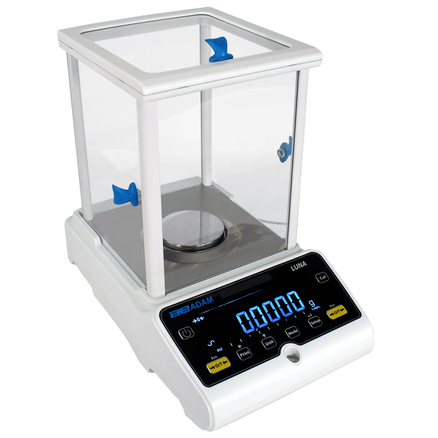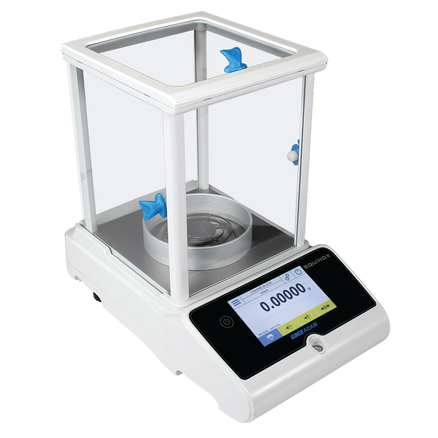
Precision Balance vs Analytical Balance: What's the Difference?
Precision and analytical balances are often confused with one another, but it’s important to know the difference so you can choose the best one for your needs. This blog will describe what a balance is, what precision, analytical, semi-micro and top-loading balances are, and supply some examples of the precision and analytical balances that Inscale offers. Let’s go!
What is a Balance?
When you have an unknown mass, a balance can figure out its weight by balancing it with a known mass. To do this, balances use a force restoration mechanism, which creates a force to balance the unknown mass. The force needed to balance the weight of the object is what gets displayed on the screen. This is opposed to a scale, which uses springs or strain gauge load cells to measure deflection to display the weight. Balances are more sophisticated than scales and are used for higher-level weighing where accuracy is especially important, such as in laboratories or universities.
What is a Precision Balance?
Precision balances have lower readability and capacity than most other scales and balances besides analytical and semi-micro, but they’re not meant (despite their name) for extremely precise weight measurements. A precision balance can be used in laboratories or pharmacies but also in less sterile environments like outdoor fieldwork or manufacturing, depending on the type you get. They typically offer functions such as parts counting, dynamic weighing, percentage weighing and more. The readability on Inscale’s supply of precision balances can range from 0.001g on the most accurate options to 1g for more industrial balances, while the capacity can be as low as 122g to as high as 100kg!
An example of how precision balances may be utilised is weighing blood bags in the medical field. Blood bags are too heavy to use with an analytical or semi-micro balance, but precision balances have a large enough pan and high enough capacity to handle a full blood bag while still providing exact weight readings.
What is an Analytical Balance?
Analytical balances are the next step up from precision balances in terms of, well, precision. Analytical balances are typically found in laboratories and are precise enough that precautions must be made so that outside influences like vibrations, air currents or static electricity don’t affect the readings. Luckily, many analytical balances come equipped with draft shields to protect against air currents. However, an anti-vibration table and an ioniser may still need to be purchased.
Analytical balances offer fewer functions with only parts counting and occasionally checkweighing applications in addition to regular weighing. The readability of Inscale’s analytical balances range from 0.00001g (0.01mg) to 0.001g, while the capacity ranges from 5.2g to 520g.
An example of a situation that may require an analytical balance is if you need to perform quantitative analysis on a chemistry sample.
What is a Semi-Micro Balance?
You may see that some products on our site are called Analytical and Semi-Micro Balances. This is because a semi-micro balance is a type of analytical balance. Semi-micro balances can provide even greater precision in weighing than a standard analytical balance, with lower readabilities. They’re used to weigh small objects, such as powders, drugs or chemicals in the pharmaceutical industry with extreme precision. With this extreme precision comes extreme sensitivity as well. Semi-micro balances must be used in conjunction with an anti-vibration table, draft shields, and an ionizer (both the draft shields and ionizer are included in Inscale’s one and only semi & microbalance). Semi-micro balances can have readabilities ranging from 0.0001g to 0.01mg, with capacities from 5.2g to 520g.
What is a Top-Loading Balance?
A top-loading balance simply means that you load samples directly onto a larger, typically round or square, weighing pan, rather than placing the sample inside a weighing chamber. Top-loading balances can have large capacities with higher readabilities, making them perfect for applications where precision is still necessary, but the sensitivity of analytical and semi-micro balances is inconvenient, such as when material testing in construction or engineering environments. The readability of Inscale’s top-loading balances range from 0.0001g to 1g, with capacities from 100g – 101kg.
Examples of Precision and Analytical Balances
Now that we’ve described the differences between precision and analytical balances, we’ll provide three examples of each, so you’ll be able to make the best choice for your needs.
Precision Balances
A&D GP IP65 Industrial Precision Balance

Capacities: 30kg – 100kg
Readabilities: 0.1g – 1g
A&D’s GP IP65 Industrial Precision Balance is meant for weighing in industrial labs as well as industrial warehouse and testing environments. Its IP65 rating, sealed keypad and stainless-steel pan protect against dust, water and corrosion. When you need to weigh heavy samples with great precision, the GP is right for you.

Capacities: 220g – 12kg
Readabilities: 0.001 – 0.1g
Kern’s EW-N Precision Balance is a highly exact top-loading balance. The EW-N is perfect for both research and science labs as well as production and manufacturing applications. EW-N offers shock-proof ABS plastic casing to protect it from demanding environments. This is a fantastic mid-line precision balance!
Adam ‘Equinox’ Precision Balance

Capacities: 360g – 8.2kg
Readabilities: 0.001g – 0.01g
The Adam ‘Equinox’ Precision Balance is an exceptionally exact laboratory balance, with a wide array of features to make weighing processes easier, faster and more accurate. The Equinox is unique in that it offers a full colour touchscreen display for intuitive use. It also supplies a built-in memory for storing products and settings as well as many options for data connection.
Analytical Balances
Kern ADB/ADJ Analytical Balance

Capacities: 120g – 210g
Readabilities: 0.0001g
Kern’s ADB/ADJ Analytical Balances are ideal for educational environments, research facilities and jewellers, rather than laboratories. Its compact build saves space on any bench top and its 6-key display keeps things simple. If you’re a jeweller, the ADB/ADJ features a carat weighing unit as well as parts counting and percentage weighing functions. This scale is great when you’re on a budget!
Adam ‘Luna’ Analytical Balance

Capacities: 80g – 250g
Readabilities – 0.0001g
Adam’s Luna Analytical Balance is the perfect mid-range choice! With ABS plastic construction and a grade 304 stainless steel pan, Luna is easy to clean and can withstand demanding laboratory use. Luna offers a parts-counting application to save you time and effort, as well as a USB and RS-232 interface so that it can be connected to computers and printers easily.
Adam ‘Equinox’ Analytical & Semi-Micro Balance

Capacities: 120g – 510g
Readabilities: 0.01mg – 0.0001g
You read that right, Adam offers an analytical Equinox, too! Adam’s ‘Equinox’ Analytical & Semi-Micro Balance is the top of the line for analytical balances. The Equinox Analytical features parts counting and checkweighing applications as well as a preset tare function to speed up the process of repetitive weighing. With its exceptional readabilities for such a wide range of capacities, the Equinox is perfect for extremely precise weighing tasks.
Do you have any questions about which balance is best for you? Contact Inscale!

Leave a comment